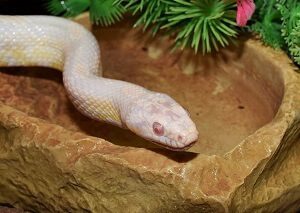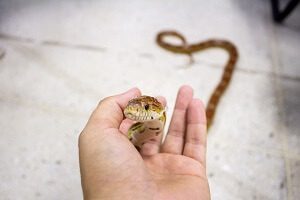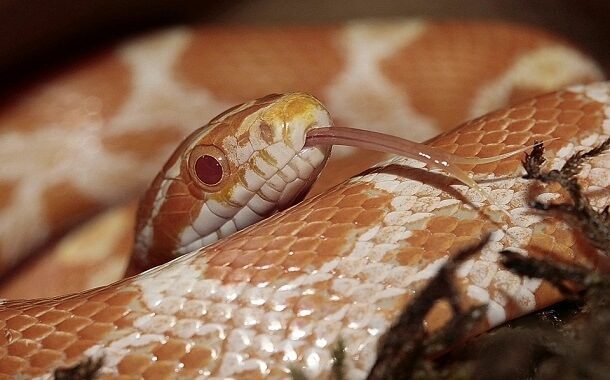How Much Does a Corn Snake Cost?
Last Updated on December 28, 2023
Written by CPA Alec Pow | Content Reviewed by ![]() CFA Alexander Popinker
CFA Alexander Popinker
The corn snake (Elaphe guttata or Pantherophis guttatus), according to the new taxonomy, is a species of constrictor snake that belongs to the Colubrid family, from central and southeastern North America. The species is called “corn” because it is commonly found in the area of grain silos, where it feeds on its favorite food, rodents (mice and rats).
Because it is a very easy-to-maintain snake, not very aggressive, and extremely beautiful in terms of color, the corn snake quickly made its place among exotic pet hobbyists. It is considered a snake for beginners, and since it does not grow very much, it does not require much space.
How Much Does a Corn Snake Cost?
Depending on its morph and length, the cost of a corn snake will be anywhere between $35 and $720, but some rarer morphs cost more than $1,100.
Exotic or uncommon baby corn snakes often come with higher price tags, sometimes exceeding $1,000. As an example, in 2023, a Tessera Corn Snake for sale is typically available for about $250, whereas a Baby Blood Red Scaleless Corn Snake, which belongs to a rarer morph category, can have prices of up to $500.
Pet corn snakes are a very easy species of snake to find, as stores are abundant throughout the country that sell them. You can check in your area for local reptile clubs or breeders who have stocks available and even purchase online if you’re looking abroad.
It is important to say that there are states where the custody of corn snakes is regulated by special laws.
For example, Georgia has a list of nonvenomous snakes that are illegal to capture, harass, or kill and corn snake is on this list. On the other hand, in New Jersey, it is allowed to buy only some morphs like Creamsicle, Lavender, Albino, Snow, Blizzard, Candy Cane, Butter and Tessera Corn Snake.
 The cost of a corn snake is not just determined by its length. The variations within the pattern also affect pricing on marketplaces, with more complex versions being much pricier than simple designs that only have two colors or outline shapes. Below you will find the average costs for some of the most common corn snake morphs:
The cost of a corn snake is not just determined by its length. The variations within the pattern also affect pricing on marketplaces, with more complex versions being much pricier than simple designs that only have two colors or outline shapes. Below you will find the average costs for some of the most common corn snake morphs:
Lavender corn snake – Their color is quite striking, presenting a pink-purple-gray pattern on a white or gray background. Some specimens have strange red eyes that seem to glow, just like the ghost corn snake. It can be bought for around $80.
Okeetee corn snake – This snake is essentially the “perfect corn snake.” Most have dark red dorsal spots, surrounded by light black edges. There are two known types, scaleless and classic. The most expensive is the scaleless one with a price anywhere between $260 and $1,250, while the classic one costs $45 to $65.
Amelanistic corn snakes – It means “without black pigment”, a condition also called albinism. This feature led to the creation of stunning, brightly colored corn snakes, or a completely white coloring. It can be bought for around $50.
Complete albino corn snake – It is also known as a Snow corn snake. It has pinkish coloration and ruby eyes and costs around $55.
Black corn snake – This snake can be black or grey due to the lack of pigment erythrin. Its price is anywhere between $40 and $55, depending on the size.
Corn snakes are not like other pets you can buy from the pet shop. You need to purchase all of their shelter needs, which cost about $160 in total. A complete set can be bought from the pet shop or online at the same time you buy the terrarium and includes decorative plants, bedding, a thermometer, a heat bulb, a water conditioner, a lamp fixture, and a Habba hut.
Corn snake details
These snakes grow between 20 and 70 inches, and females are slightly longer and thicker than males. They live in the wild for an average of 8 years, but in captivity, they can exceed 20.
One reason why corn snakes are so popular is because of their extreme diversity in color and appearance. Breeders are constantly coming up with new variations and varieties (morphs) of color.
The corn snake reaches sexual maturity at the age of 18-24 months. Before mating, adult corn snakes must be fed very well. In November it is good to start the hibernation period, and the temperature in the terrarium should be gradually reduced, by 1 degree per day, until it reaches the value of 52 degrees.
Snakes should then be left at this temperature for a month. During all this time, pet owners will not fed the snakes at all. After mating, the female lays about 12 to 24 eggs, which will be left in the incubator for 65 days.
Cost of owning a Corn snake
Corn snake enclosure
The Corn Snake is not large, but it is very active and loves to explore and climb, so it needs a medium-sized glass aquarium, longer than it is tall. A medium glass aquarium with dimensions of 120x60x60 centimeters is ideal for this snake. When small, baby Corn Snakes are usually kept in a larger jar. Depending on the size, you will pay around $125 or more for a glass aquarium as the corn snake’s enclosure.
The corn snake needs a hiding place. Let your imagination run wild when arranging the nursery and choose the perfect hiding place. Bark, rotten logs, cardboard or plastic boxes, commercial decorations, anything can become a snake’s favorite hiding place.
It needs to be snake-sized and to have enough space inside for it to curl up. A high-quality substrate in the carving also often offers a place to hide, so don’t be surprised if you don’t see your snake. However, if you want to purchase an artificial hiding area it may cost around $25.
The corn snake is one of the few pet snakes that also need branches or wooden sticks to climb on. If you opt for the natural ones, make sure that they have not been treated with pesticides, and that they are clean and disinfected.
Leave them in the oven at 392 degrees Fahrenheit for 15 minutes, which should make them harmless to the snake’s health. The stick can be placed from one corner to another, diagonally to the container, or in any other way, but it has to be easily approachable by the snake.
Plastic plants can provide more richness to the environment but are not essential. So, you should budget around $15 for branches and décor.
You might also like our articles about the cost of a tarantula, iguana, or chameleon.
Corn snake consumables
As in many other cases, there are disputes over the ideal bedding. Newspaper or paper strips are the most accessible and also the cheapest. In addition, when moistened, they can be easily replaced. However, the lead in the newspaper is harmful to the snake’s eyes. Many specialists avoid this type of substrate.
Pine fiber bedding or crushed pine bark is one of the most commonly used bedding. It is a good absorbent and dirty areas can be easily removed and replaced with clean bedding. Snakes can swallow this substrate and digestive problems can occur, but only if the granulation is very large. Cedar fiber bedding is totally forbidden. In local pet shops, you will find special bedding for reptiles, which is not treated with pesticides or other chemicals. The price of a bag of such a substrate can cost anywhere between $12 and $25 and would be enough for 4 to 6 weeks.
Indoor or outdoor lawn carpet is another substrate variant. Gives a pleasant appearance to the vivarium environment the snake requires. Unfortunately, when it gets dirty, it must be changed, washed, and dried. That’s why it would be best to have two pieces to keep rotating. Depending on the size, expect to pay $10 to $32 for a reptile mat.
Corn Snake habitat
Snakes drink water and sometimes need a water bowl to take a bath. A shallow bowl of water should always be present. Bowls for dogs or cats can be used for this purpose. During the shedding period, the snake enters the water to get rid of the skin more easily.
It is also a good idea to spray the snake daily with a sprayer. Otherwise, once a week the fine spray of water ensures the right humidity. You can measure it with the help of a dual humidity gauge and thermometer that costs around $15.
Corn snakes need to be heated as they will have a lot to gain from a temperature gradient in the aquarium. This gives them the ability to thermoregulate, aid digestion, and helps maintain a strong immune system. They thrive in the same temperature range as humans, between 70°F and 87°F. It is necessary to provide a “hot spot” in a portion of the enclosure, where the snake can warm up. You can purchase a heat lamp that costs around $4 or a heating pad for around $17.
Corn snake feed
Feeding the corn snake is relatively easy. In the wild, corn snakes are carnivores that feed almost exclusively on warm-blooded prey, such as rodents and birds.
A food of adequate size is not more than 1.5 times the width of the snake’s body. Corn snakes eat both dead and live food, like mice and small rats, generally 1-2 animals a week. They like to hunt and feed, so it is best to use live or recently killed and thawed prey. Frozen rodents are sold online and you can purchase them in bulk quantities at prices of $0.35 to $1.30.
Corn snake care
Corn snakes are among the toughest snake species in existence. In addition to being susceptible to the same disorders that can affect any snake (mites, parasites, respiratory infections such as pneumonia, prey bites, etc.), corn snakes can have shedding problems.
In case any of these problems appear be prepared to spend anywhere between $45 and $110 for the first vet visit.
It is important to mention that not all vets handle exotic animals and it may be hard to find one close to you. So, you should budget anywhere between $820 and $1,300 as emergency funds in case your snake gets sick.
It is very important to keep the snake’s aquarium clean. The enclosure needs to be cleaned with a special cleaner that can cost around $15.
Important things to consider
The glass aquarium must have holes for ventilation. If the enclosure has a wire mesh cover, make sure it is not too rough. Otherwise, the snake could be injured.
 No lighting is required. In some species the color looks better in daylight. If you want to use a fluorescent light bulb to enhance the beauty of your pet, you can do so.
No lighting is required. In some species the color looks better in daylight. If you want to use a fluorescent light bulb to enhance the beauty of your pet, you can do so.
Whatever you decide, never put a light bulb in the aquarium. Snakes tend to wrap themselves around lights and will burn themselves.
After feeding, do not disturb the snake for about 24 hours, giving it time to digest the food. Handling a snake too early or too suddenly after eating can cause it to regurgitate the food.
Shedding problems are almost always caused by a lack of moisture inside the aquarium. As a corn snake approaches the shedding period, its eyes will turn blue and opaque. This is the signal that the shed will start in 4-10 days.
Most often, the Corn Snake is sensitive to bacteria that it can contract, especially through terrarium water. Because it likes to defecate in water, it must be changed daily.
Also, the snake should not be exposed to mold, as its spores quickly penetrate the lungs of the Corn Snake and will kill it immediately.
The corn snakes make great pets being docile, gentle, and friendly specimens. But it is a master of escapes, so the terrarium in which it lives must have no cracks and should be closed with a lid. It is a very active snake, which in the wild spends a lot of time on the ground, but also likes to climb trees and buildings, and gets under stones, logs, and other debris.
When to call the vet?
Corn snakes suffer from the problem of tying eggs. This happens when the snake is unable to expel eggs formed in the body, resulting in a fat deposit called “hips”. It is a serious problem and it is best to seek the help of a veterinarian. Any female snake can lay eggs even in the absence of a male. But these eggs are not fertile.
If your corn snake has shedding problems, try soaking the snake in a bowl of water for up to half its body for up to 24 hours. In extreme cases, you can help your snake with tweezers. If the skin on the eyes does not come off between 2 sheds, you should seek veterinary care.
Buying tips
People who want to buy a Corn Snake should go for a captive specimen. When buying a snake, you should make sure it isn’t weak or has wounds and scratches on the body. They must also have no ticks or mites.
Buyers should also make sure that the Corn Snake has clear eyes, a clean anal orifice, is alert, and is quick to shake its tongue. In addition, a healthy snake has a firm, round body, smooth breathing, a closed mouth, a pink color inside the mouth, glowing skin, and smooth movements.
It is good for snakes to be bought from breeders or clean pet stores.


Leave a Reply
Want to join the discussion?Feel free to contribute!